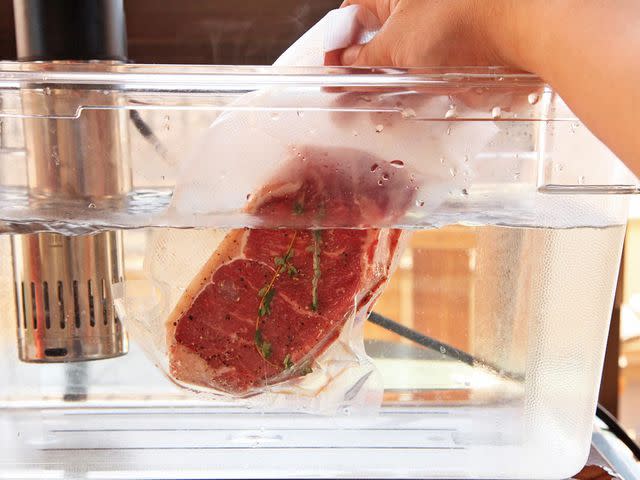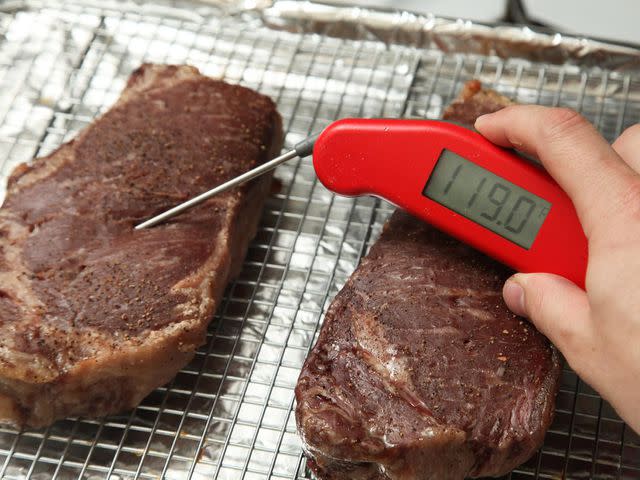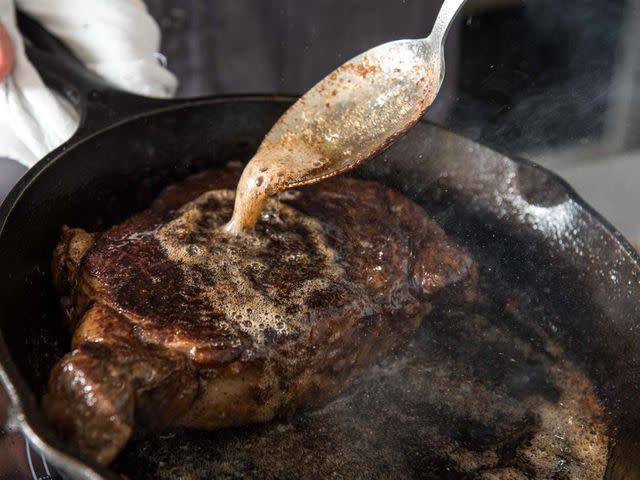The Best Ways to Cook Steak, Explained
There are many ways to cook a steak. Let's look at the pros and cons of three of the most common ones.

Is there one single way to cook a steak that's better than all others? That's the question I attempt to answer here and in the video above. After all, who doesn't want to live a superior life full of excellence and efficiency? If I had it my way, everything I did would be optimized for quality and ease, from storing tomatoes (it's complicated) to brushing my teeth (never had a cavity in my life, so I can't be too far off).
The answer, as is the case with many things in life, is this: It depends. The best way to cook steak hinges on personal preferences and the context in which you'll be cooking. Do you value a more perfectly even gradient of doneness from edge to edge or a deeper, crustier sear on the exterior? Will you be making just one or two steaks, or are you feeding a crowd? And just how adept of a cook are you? The answers to these questions will often lead you to a different steak-cooking conclusion.
Let's take a closer look. Before we continue, though, a couple of necessary qualifiers. First, I excluded grilling from this showdown, instead limiting my analysis to "indoor" cooking methods that involve finishing the steak on a stovetop, since grilling opens up a wider set of variables that are harder to parse (for starters: what kind of grill and fuel source do you use?). Still, it's worth noting that both sous vide and the reverse-sear can be finished on the grill, something that isn't true of the butter-basting method.
Second, this analysis pertains to thicker steaks, ones that are least 1 1/2 inches thick. That's because thinner steaks cook more quickly, often hitting their ideal doneness in about the same time it takes to get a decent sear on each side, rendering the three methods examined here more or less unnecessary—if searing alone yields a perfect steak, there's little need for additional techniques to get you there.
The Pros and Cons of Sous Vide

Brace yourselves, sous vide enthusiasts, because I'm not going to declare this the obvious winner and end the article here. Sous vide is a useful cooking technique with plenty to praise about it, but it's not without its downsides. For a deeper look at sous vide steak, read our guide here.
Sous Vide Pros: Sous vide is by far the easiest, most foolproof method for nailing your ideal steak doneness. Set your water temperature, drop the bagged steaks in, and wait. There's absolutely no risk of overcooking, though steaks left for more than four hours in a hot-water bath will begin to exhibit increasingly undesirable textural changes. This makes sous vide an excellent choice for people who have limited cooking skills or who want the benefit of the most hands-off of all these methods. For me personally, that level of ease is particularly appealing if I'm cooking multiple steaks for a crowd or just entertaining in general—with the steaks safely hanging out in their hot-water bath, I'm free to hang out with my friends worry-free. When it's time to eat, I just need a minute to put a finishing sear on them, and we're ready to go.
Sous Vide Cons: Because the steaks are sealed in a plastic bag, they remain wet throughout the sous vide process. This leads to a problem when it comes time to sear, since water is the enemy of browning. Yes, you can and should dry them off with towels after they come out of the bag, but you'll never dehydrate the meat's surface as well as the other methods do. This leads to a choice: Accept a less-than profound sear (the Maillard reaction is, after all, where much of the good flavor of steak comes from) or sear the steak harder for longer, which will undo some of that perfect edge-to-edge doneness gradient sous vide otherwise guarantees.
The Pros and Cons of Reverse-Sear

Kenji has previously declared the reverse sear to be the best way to cook a steak, "period." And I'll agree that he has a very strong argument to support that claim. But I'd probably qualify it just a little bit. If we're looking for the "Goldilocks" method, the one that strikes the most perfect balance of all possible considerations, the reverse-sear is the clear winner. What you get with the reverse-sear—a method that involves slowly heating the steaks in a low oven until your desired internal temperature is reached before finishing in a hot skillet—is the ideal combination of ease, maximum sear, and an even gradient of doneness. All in all, it's the method I'd recommend for most people, most of the time.
Reverse-Sear Pros: Like sous vide, the reverse-sear starts the steaks at a low temperature, gradually heating the meat to your desired level of doneness, before ending with a sear in a hot skillet. It's not as foolproof as sous vide, since you do have a small risk of accidentally overcooking the meat—your oven is neither as accurate as an immersion circulator nor capable of the same low temperatures. But the meat heats slowly enough that it's still far more foolproof than a high-heat method like butter-basting. It also delivers an impressively even inner gradient of doneness, thanks to that low-and-slow approach. Plus, because the steaks cook uncovered in the dry oven heat, their surfaces dehydrate, so that when you do sear them, you'll get a much better and more deeply flavorful crust than sous vide.
Reverse-Sear Cons: The reverse-sear is a relatively foolproof method, but it's not risk-free. You can overcook your steaks, and, assuming you're not using a probe thermometer with an alarm, the overall hands-off nature of the method can allow the cook to become just a little too inattentive: Get distracted and miss that moment of perfect doneness, and you've just squandered your investment of money and time. And, while the reverse-sear delivers a steak with an inarguably delicious crust, it's not the ultimate crust—unless, as with sous vide, you sacrifice that more perfect inner doneness in search of a deeper sear.
The Pros and Cons of Butter-Basting

Cooking a steak from start to finish in the skillet while basting it with hot butter is the old-school way of doing it. Being the OG, though, doesn't make it the automatic winner. As you'll see, just like the other two methods, this one comes with its advantages and disadvantages. But I'm not going to hide my opinion (watch the video, and you'll see I can't): This is my personal favorite. I'm partial to the deeper, more flavorful sear and crispier crust butter-basting delivers compared to the other two, and I'm willing to accept a small band of grayness under the surface to get it. I don't expect everyone to agree with me—your priorities may well be different.
Butter-Basting Pros: Because the steak spends the duration of its cooking in a hot skillet, you maximize the time you have to develop that roasted exterior. It's the sizzliest, crispiest, roastiest of them all. That means maximum flavor and maximum textural contrast between the crunchy surface and tender center. The steak also spends the most time in a bath of increasingly flavorful butter as it browns and infuses with the herbs and aromatics you've (hopefully) added to the pan.
Butter-Basting Cons: There are a few downsides to this one. The first is that it's the least foolproof. You're working with high heat from the beginning, which means the steak cooks faster and the window of opportunity to pull it from the skillet at just the right moment is small. Of all three methods, it's also the most difficult to do for more than one or two servings. And while it's the fastest of the three in terms of total cooking time, it is the most involved in terms of active cooking time, which means you're chained to your stove from the minute you begin until the minute you're done. It also, inevitably, delivers a steak with a more noticeable gradient of doneness, with a thin inner line of more well-done meat under the surface that transitions to your ideal inner temp as you get closer to the center. I find this band to be minimal when butter-basting is done properly, so it's not a big deal to me, but others may find that they just can't tolerate anything other than the near-total absence of a gradient that sous vide or the reverse-sear deliver.
So as you can see, there's no one right answer here. The real answer to the question of what the best way is to cook a steak is this: How confident of a cook are you? How many people are you serving? And, most importantly, what does a perfect steak look like to you?